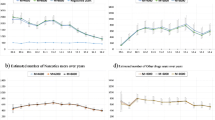Abstract
Service provision and treatment outcome for problem drug users are receiving increased attention, although both are hindered by the lack of good epidemiological data. A technique of population enumeration called capture recapture methodology (CRM) is currently being advocated for use in populations that are otherwise hard to count. CRM is explained and some of its limitations discussed. Studies that have used this methodology are examined.
Similar content being viewed by others
References
Bishop YMM, Feinberg SE, Holland PW (1975) Discrete multivariate analysis: theory and practice. MIT Press, Cambridge, Massachusetts
Cormack RM (1989) Log-linear models for capture-recapture. Biometrics 45: 395–413
Department of Health and Social Security (1988) AIDS and drug misuse. Part 1. Advisory Council on the Misuse of Drugs, HMSO, London
Drucker E, Vermund SH (1989) Estimating the population prevalence in human immunodeficiency virus infection in urban areas with high rates of intravenous drug use: a model of the Bronx in 1988. Am J Epidemiol 130: 133–142
Fisher N, Turner SW, Pugh R, Taylor C (1994) Estimating numbers of homeless and mentally ill people in north east Westminster by using capture-recapture analysis. BMJ 308: 27–30
Frischer M (1992) Estimated prevalence of injecting drug use in Glasgow. Br J Addict 87: 235–243
Frischer M, Bloor M, Finlay A et al (1991) A new method of estimating prevalence of injecting drug use in an urban population: results from a Scottish city. Int J Epidemiol 20: 997–1000
Frischer M, Leyland A, Cormack R et al (1993) Estimating the population prevalence of injection drug use and infection with human immunodeficiency virus among injection drug users in Glasgow, Scotland. Am J Epidemiol 138: 170–181
Hartnoll R, Lewis R, Mitcheson M, Bryer S (1985) Estimating the prevalence of opioid dependence. Lancet I: 203–205
Hook EB, Regal RR (1992) The value of capture-recapture methods even for apparent exhaustive surveys. Am J Epidemiol 135: 1060–1067
LaPorte RE (1994) Assessing the human condition. (editorial). BMJ 308: 5–6
LaPorte RE, McCarty DJ, Tull ES, Tajima N (1992) Counting birds, bees and NCDs. Lancet 339: 494–495
McCarty DJ, Tull ES, Moy CS, Kwoh CK, LaPorte RE (1993) Ascertainment corrected rates, applications of capture-recapture methods. Int J Epidemiol 22: 559–565
McKaganey N, Barnard M, Leyland A, Coote I, Follet E (1992) Female streetworking prostitution and HIV infection in Glasgow. BMJ 305: 801–804
Parker H, Bakx K, Newcombe R (1988) Living with heroin. Oup, Milton Keynes
Payne CD (1986) The GLIM (generalised linear model) system, release 3.77. Numerical Algorithms. Oxford, England
Seber GF (1982) The estimation of animal abundance and related parameters, 2nd edn. Griffin, London
Squires NF, Beeching NJ, Schlecht BJ, Ruben SM (1995) An estimate of the prevalence of drug misuse in Liverpool and a spatial analysis of known addiction. J Public Health Med 17: 103–109
Author information
Authors and Affiliations
Rights and permissions
About this article
Cite this article
Cox, S., Shipley, M. Counting the uncatchable?. Soc Psychiatry Psychiatr Epidemiol 32, 19–23 (1997). https://doi.org/10.1007/BF00800663
Received:
Issue Date:
DOI: https://doi.org/10.1007/BF00800663




